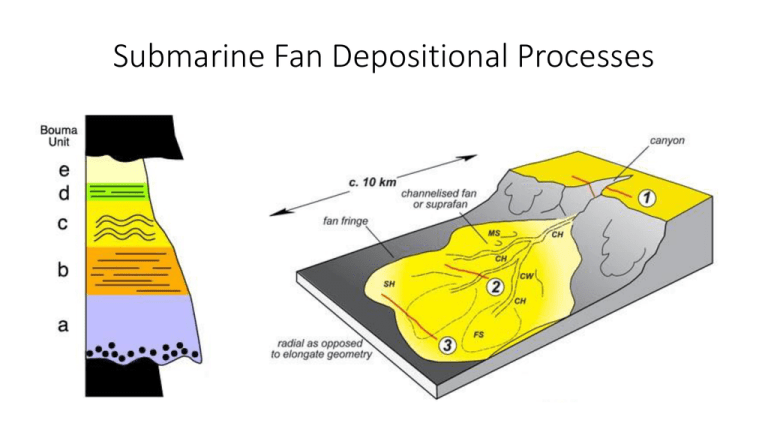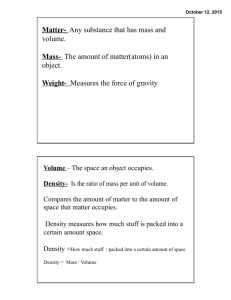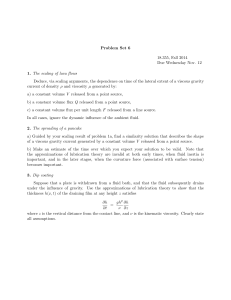Submarine Fan Depositional Processes: Turbidity Currents
advertisement

Submarine Fan Depositional Processes Deep-Sea Flows The 1929 Grand Banks earthquake severed submarine telegraph cables up to 700 km from the epicenter and 13 hours after the earthquake Turbidity current: sediment-gravity flow with fluid (Newtonian) rheology and sediment supported by turbulence Turbidity currents driven by density contrast between suspension and surrounding fluid Δ𝜌𝑔ℎ Energy balance: 𝑢ℎ𝑒𝑎𝑑 = 𝑘 𝜌𝑓𝑙𝑢𝑖𝑑 Gravity Fluid resistance + particle suspension When slope decreases below critical value for supercritical flow (slope ≥ 0.5°), turbidity current undergoes hydraulic jump Enhanced turbulence and flow homogenization Marks transition from steady-state erosive or bypass flow to waning depositional flow Waning turbidity currents are very mildly dissipative and can flow over distances of as much as ~5000 km Deposition from turbidity currents occurs during waning flow and dissipation of the current 1) Density reduction – sediment loss or mixing of ambient fluid (Dr) 𝑢ℎ𝑒𝑎𝑑 Δ𝜌𝑔ℎ =𝑘 𝜌𝑓𝑙𝑢𝑖𝑑 2) Flow thickness reduction – stretching, collapse, spreading (h) 3) Friction at base and upper surface of flow Sedimentary deposit formed by a turbidity current is called a turbidite Due to the Newtonian flow rheology, turbidites are typically very laterally extensive, thin beds (typically 5-20 cm) Unhindered settling generates graded beds Particles sink through fluid at constant terminal velocity, but what is that velocity? FD FB Forces acting on sediment particle include: FG Gravity Drag (Fluid Resistance) Gravity FG = 4/3 p r3 rs g Buoyancy Buoyancy FB = 4/3 p r3 rf g When particle sinks at constant velocity: upward forces balanced by downward FG = FB + FD At terminal sinking velocity: FG = FB + FD FD FB Gravity FG = 4/3 p r3 rs g Buoyancy FB = 4/3 p r3 rf g Given similarity of gravity and buoyancy: FG FG – FB = FD FG - FB is “effective gravity” = 4/3 p r3 (rs-rf) g or 1/6 p D3 (rs-rf) g What about fluid drag FD? Fluid drag has a viscous component and an inertial component, but for simplicity we will just consider viscosity Viscosity m is the amount of fluid movement (strain) for a given shear stress t: t m= δu δy or t m= u D Stress (t) is just force per area, so the viscous force is: umD2 FD = D or FD = u m D um t= D At constant terminal velocity u, the downward and upward forces are balanced Downward force: Upward force: FG = 1/6 p D3 (rs-rf) g FD = 3p u m D Stokes’ Law 1 (rs−rf) u= g D2 18 m Stokes’ law describes the settling velocity of particle with diameter D and density rs (larger particles sink more rapidly) In 1962, Arnold Bouma created a generalized model for a turbidite bed, now called the Bouma sequence, based on the Annot Sandstone in SE France Sharp, unchannelized base with sole marks Bouma “Ta” division Massive normally-graded sandstone reflecting unhindered settling of particles from waning Newtonian and turbulent flow Technically, should always exhibit normal grading (flow should be Newtonian, not plastic) Parallel laminated Tb, rippled Tc, faintly laminated Td, and mudstone Te divisions reflect deposition from waning flow Bouma Te division partly consists of hemipelagic (non-turbidite) mudstone E D C B Fluidized flow: rheology often plastic, sediment supported by upward flow of escaping pore fluid Fluidized flows Fluidized flows contain dewatering structures from escaping pore fluids Dewatering pillars Dish structures: concave-up mud laminae in fluidized sandstone Upward flowing pore water carries mud (“elutriation”) until it reaches and flows laterally along a less permeable barrier layer Ball-and-pillow structures A type of load structure, formed in response to gravitational instability (force exceeding shear strength of underlying layer) between denser sediment (often sand) deposited abrupt on less dense bed (often mud/silt) Flame structures: injection of liquefied lower bed into rapidly-deposited overlying unit, often pointing downcurrent Convolute bedding: deformed, swirling laminations caused by slumping of semi-lithified units; typically forms on somewhat steeper slopes





